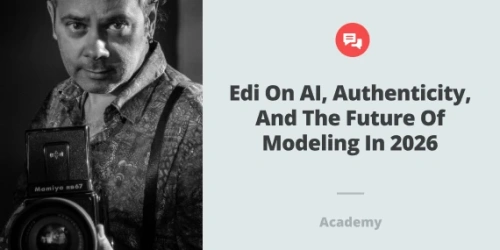How To Figure Out What Type Of Model You Aspire To Be
As aspiring models are gearing up to embark on this journey on their own, they should try to set a clearer focus on what sort of modeling specialization they wish to pursue as their main priority.
For example, commercial models are typically sporting a relatable and natural look while advertising various products in photo and video ads, while for similar mediums, editorial models are leaning more towards creativity and visual artistic expressions in industries such as high fashion. Being a runway model is a whole other thing than those two, as it requires actual real-time movements during catwalk shows in front of a larger audience than just a few photoshoot staff members during a private setting.
Even more niche modeling focus is on fitness modeling, which, of course, involves the performers showcasing an above-average athletic build of their bodies. Parts modeling may not even fully reveal its respective model, while only showcasing their, for example, hands or feet. Finally, plus-size modeling focuses on diverse body type representation during the respective projects.
While keeping their career preferences, up-and-coming models should also keep an open mind about trying various varieties of modeling to gather extra experience as well as show flexibility to their future employers. Aspiring performers should also remember that the modeling industry is highly prone to changes, which means that closely following its trends will allow them to stay in demand and a step ahead of the competition.
All You Need To Know About How To Create A Modeling Portfolio
Modeling portfolio is an absolute must-have from the moment a model decides to pursue casting calls, as it serves as the first introduction of the respective performer to the industry professionals, including casting directors. When working without a talent agency, the model has to create the portfolio from scratch on their own.
For models, of course, visual appearance is what casting staff will be looking for as a priority. This means investing in professional headshots is certainly a no-brainer for every model, regardless of the experience level they have. First of all, that is because a photographer who specializes in that sort of shots will be able to reveal what poses and looks flatter the particular model the best. Secondly, professional photographers are also highly skilled at various technical aspects of creating modeling headshots, including lighting and compositing. Industry professionals will always be able to tell the difference between this type of photograph and the type that the casting call candidate has shot on their own with their smartphone, thus aspiring models risk giving off an unwanted sort of first impression.
Photographies included in the portfolio should also represent the potential diversity possibilities of the model, e.g., conveying varied emotions and styles. This is why, besides the headshots, it is also highly advisable to add full-body shots to the portfolio, as well as photos that appeal to editorial and commercial fields. Editorial style photos will further showcase the model's ability to work with varied concepts of projects, while commercial style photos will showcase the individual’s general marketability. Also, when it comes to photos included in the modeling portfolio, it should always be a quality over quantity type of approach to the added footage.
Of course, all the basic information for modeling portfolio is a must-have requirement, the same as it would be for a resume in any other type of job field. Every model should include their name and surname, contact information, including phone number and email, as well as varied information about their visual appearance, e.g., height, waist, hips, shoe size, eye color, hair color, and more. Every bit of modeling experience and training, as well as relevant skills, should all be included as well - a single thing that fits what the respective project needs can sometimes decide the fate of a casting call candidate.
Due to not having a modeling agency representing them, a strong social media presence is also important for independent aspiring models. Platforms such as Instagram and TikTok can be leveraged for branding themselves through maintaining a certain aesthetic of how they wish to be perceived as models, while LinkedIn can give an extra boost to modeling job search due to its networking focus.
How Models Can Find New Modeling Gigs By Themselves
When working independently, it means models have to search for employment opportunities themselves. Thankfully, the process of finding modeling gigs is not much different from other professional industries, where workers typically also search for jobs on their own.
Long gone are the days when models had to line up with a portfolio in hand to await the unknown, as casting announcements are now being published daily on online platforms specifically focusing on casting calls and auditions, as well as websites and apps from the brands and companies directly. Aspiring models can also identify specific brands and companies that they would specifically like to work for and be on the lookout for new opportunities with them. Sometimes users can even set up a sort of alarm for themselves on the platforms to not miss out on new casting calls that fit their previously selected criteria of interest.
You might also be interested in:
When finding the casting call that interests them, models should make sure they fit and can fill all the specific requirements, as casting directors are highly unlikely to make exceptions in the case of unfilled blanks. In most cases, the initial information required will be the modeling portfolio as previously described in this blog post. What every model should hope for next is the invitation to audition for the project, which may take place in person, online, or even through a self-taping. In this case, it is very important to always remain punctual and professional from the very beginning, as modeling auditions, photoshoots, and everything else typically is time sensitive. Part of the modeling industry is also sometimes receiving declining answers, which means it is also important to show resilience and maintain a positive attitude towards the whole process.
In the case of successfully auditioning and getting the modeling gig, the independently working performer is also responsible for the legal and financial agreements that come with the job, e.g., image usage rights, payment terms, cancellation policies, and exclusivity agreements, which may restrict the model's employment options for a specific time period.
Working as a model without agency representation may be demanding and requires self-discipline, yet in today’s day and age, it is arguably easier than ever to maintain independence while trying to achieve modeling dreams.



